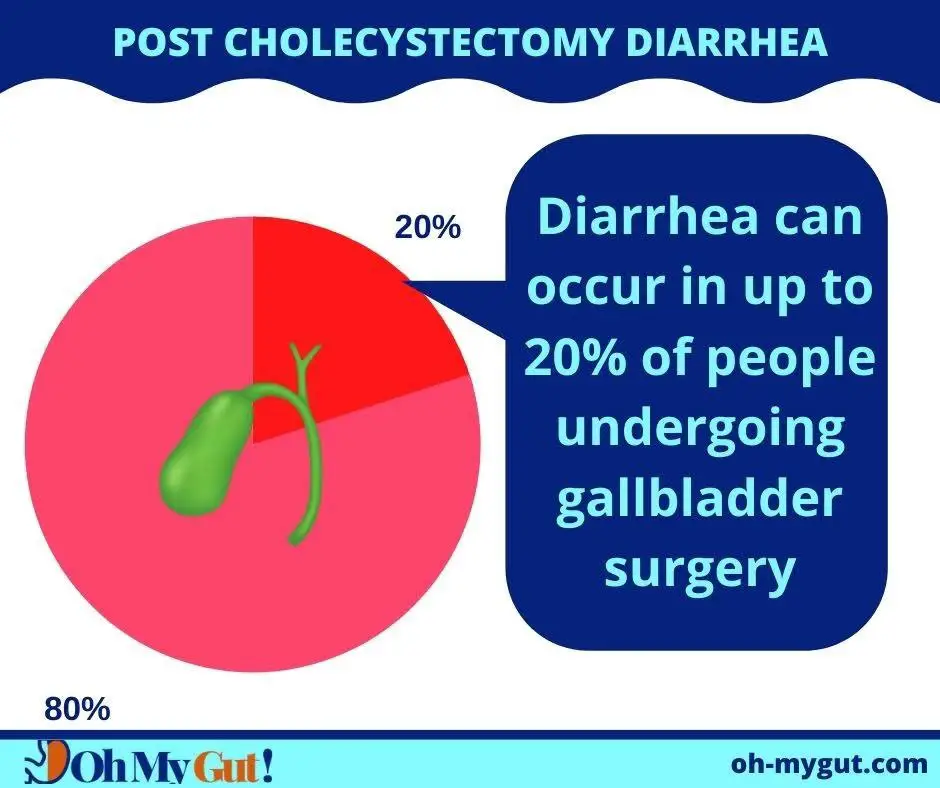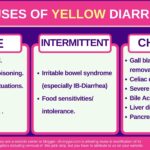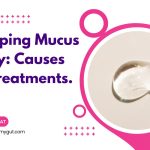Diarrhea After Gallbladder Removal: Causes, How Long It Lasts? & Treatment.
What causes diarrhea after gallbladder removal?
Bile (secreted from your liver) is stored and concentrated inside a pocket attached to the liver. This pocket (the gallbladder) then secrets the concentrated bile into your duodenum together with pancreatic enzymes to help digestion (ref).
The majority of bile inside your small intestine (80-90%) is reabsorbed again before reaching the colon.
This on-demand (with meals) secretion of bile prevents the accumulation of bile inside your intestines.
After the gallbladder removal, some people may experience diarrhea for a few days or weeks. in some cases, diarrhea may last for years. The cause is usually due to the inability of your intestine to handle excess bile. Diarrhea can be yellow or bright yellow due to its fat content.
The exact mechanism of how post-cholecystectomy occurs is still unclear. But the most accepted theory is (ref):
- Excess unconcentrated bile reaches your intestine even if you’re fasting.
- This may exceed the capacity of the small intestine to reabsorb it.
- And as a result, it reaches the colon and causes diarrhea (which is usually yellow or pale due to its fat content).
Water and electrolyte secretion into the colon as a result of excess bile acids leads to yellow or pale diarrhea. a condition that is known as “Bile Acid Diarrhea” or “Bile Acid Malabsorption”.
MORE:
- unusual gallbladder symptoms.
Problems After Gallbladder Removal (Years Later): Causes & Symptoms.
Constipation After Gallbladder Removal (Acute and chronic): causes and treatment.
How common is diarrhea after gallbladder removal? & how long it lasts?
Diarrhea after gallbladder removal has been reported in 5 to 12 percent of patients (ref). Usually, diarrhea lasts for a few weeks or months, but a small subset of patients may continue to suffer from diarrhea for years after gallbladder removal.
Other experts (as Dr. Michael from mayoclinic.org) states that diarrhea can occur in up to 20% of people undergoing gallbladder surgery.

In the first few days or weeks after the removal of your gall bladder, diarrhea is even more common. according to this study, nearly 50% suffer from diarrhea or loose yellow stools in the first month after cholecystectomy.
Diarrhea is more evident after eating fatty foods. Some people may not suffer from frank diarrhea, but rather loose yellow or pale stools.
Usually, BAM (Bile Acid Malabsorption) is a persistent condition. Its main symptom is persistent attacks of diarrhea.
A sudden acute attack of diarrhea starting weeks or months of gallbladder removal is probably not due to gallbladder removal. It is better to think of gastroenteritis or other food sensitivities.
What is the character of diarrhea (and colors) of diarrhea after gall bladder removal?
Diarrhea after cholecystectomy can range from mild attacks of loose stools to severe persistent diarrhea with extreme urgency.
Due to bile excess and fat maldigestion, the main color of diarrhea is usually yellow or pale. Light brown stools after gallbladder removal also can occur.
Here are the main features of post-cholecystectomy diarrhea:
- Acute onset directly after gallbladder removal.
- It usually increases after eating fatty foods.
- Diarrhea is usually watery or loose yellow stools.
- Urgency or extreme tenesmus usually occurs in severe cases of Bile acid diarrhea.
- Associated with mild abdominal pain and cramps.
- In severe cases burning and soreness in the anorectum can occur.
- It usually resolves within a few weeks or months. But some may need treatment as it can persist for years.
- Pooping pure bile is not usual after the removal of the gallbladder, but it can occur in severe cases.
How to stop diarrhea after gallbladder removal?
Usually, diarrhea will resolve spontaneously within a few weeks after gallbladder removal. Avoiding fatty and fried foods can help, but your doctor may prescribe a Bile acid-binding agent such as cholestyramine or Questran to control the condition.
The treatment of bile acid diarrhea includes:
1- Foods to avoid.
- In general, large meals are not recommended, try to eat smaller more frequent meals.
- Fatty or greasy foods.
- Whole milk and dairy products.
- Spicy foods.
- Processed foods.
- Sardines, pork, and veal.
- Onions, raw vegetables.
- Alcoholo, coffee, soda, or other caffeinated or carbonated drinks.
2- Foods to eat.
- Bananas.
- Rice.
- Apples, apple sauce.
- Toast.
- Cooked cereals
- soda crackers.
- Keep yourself hydrated, eat light meals.
3- Bile acid Binders.
This is the main type of treatment of diarrhea after gallbladder removal. Bile acid binders bind to the excess bile in your intestine and prevent its impact on your colon.
They are very effective for post cholecystectomy persistent diarrhea. it is probably the single most effective medication to control your diarrhea after GB removal.
Common Bile acid binders are:
- Cholestyramine (Questran).
- Colestipol (Colestid).
- Colesevelam (Welchol).
DON’T take these medications by yourself, ask your doctor about when and how to take them.
Your doctor will prescribe cholestyramine in small doses at first (to avoid its side effects).
- It is available in packets of powder (usually, 4 grams per dose), the starting dose is one packet per day.
- Taken mixed with water or juice.
- Your doctor may increase the dose at weekly intervals to achieve a response.
- DO NOT Sip or hold it in your mouth (as it can cause tooth discoloration or dental decay.
- It is taken one hour before or 4 to 6 hours after taking other medications (as it may interfere with their action).
But, side effects can occur, such as:
- Bloating and flatulence.
- Abdominal discomfort or pain.
- It may induce constipation, nausea, or anorexia.
- Dental discoloration.
- Vitamin malabsorption.
- Interference with other medications.
4 – Other antidiarrheals such as Loperamide (Imodium).
Other antidiarrheals such as loperamide can be used for diarrhea after gallbladder removal. But it is not as effective as bile acid binders.
Use as directed by your doctor.
How to know if the postcholecystectomy diarrhea is Bile acid malabsorption or not?
The most accepted theory for diarrhea after cholecystectomy is the inability of the intestines to handle bile.
It can simulate a condition called “Bile Acid Malabsorption” which can occur without gallbladder removal.
According to this review study, BAM (bile acid malabsorption) affects one-third of patients with IBS-D and up to 50% of patients with functional diarrhea.
Bile acid diarrhea after cholecystectomy has some distinctive features that can help identification:
- Extreme emergency.
- May lead to soiling accidents.
- Night diarrhea: that awaken you after sleep.
- Related to fatty foods.
- A specific stool test for BAM is the definitive method of diagnosis.
- Also, your doctor can prescribe a bile acid binder as a “therapeutic test” to watch its effect. A good response to cholestyramine may indicate the presence of BAM.
Related Posts:
- 6 Problems After Gallbladder Removal, Years Later…
- 5 Causes of Diarrhea After Eating Fatty Foods & Tips…
- Mucus In Stool With IBS: Causes, Different Colors, &…
- Fatty Liver Pain: Causes, Mimics, and Treatment;…
- Stomach Cramps And Gas: The 5 widespread causes…
- Safest Gallbladder Diet after Surgery (with 60+ Recipes)







